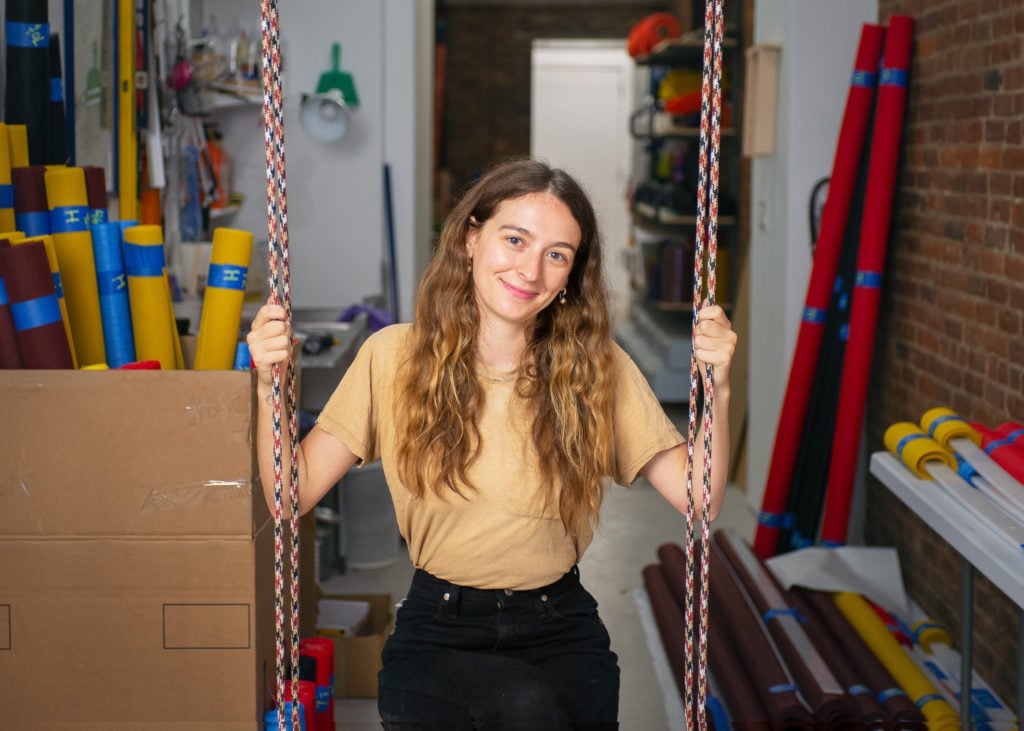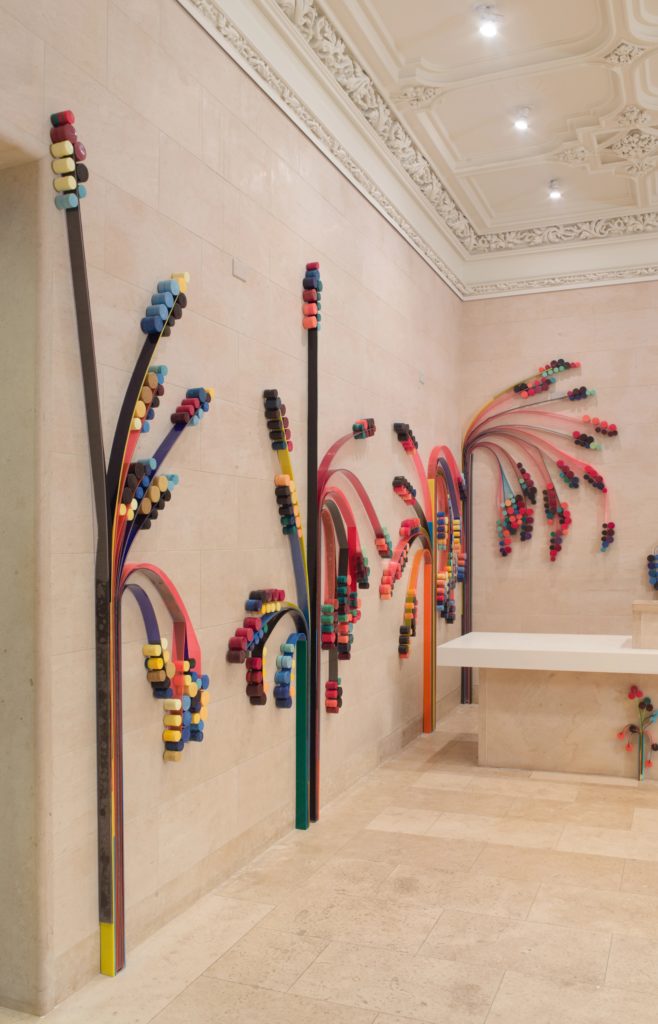People
‘People Have Given Me My Own Space’: Sculptor Eva LeWitt on Growing Up With a Famous Artist Father and Finding Her Own Voice
On the eve of a major museum exhibition, the 34-year-old artist is completing one of her most ambitious projects yet.

On the eve of a major museum exhibition, the 34-year-old artist is completing one of her most ambitious projects yet.

Taylor Dafoe

The walls of Eva LeWitt’s studio are lined with sheets of graph paper. Most have seemingly random numbers and letters printed across them, like a secret code. In fact, they’re instructions—a way of plotting out patterns that will eventually manifest themselves in one of the artist’s post-minimalist sculptures, which she creates from commonplace materials like latex, vinyl, and acetate.
If the words “artist” and “instructions” bring anyone in particular to mind, it’s almost certainly Sol LeWitt, the pioneering late minimalist and conceptual artist who also happens to be Eva LeWitt’s father. But a penchant for preparing art projects with strict internal logic is one of the only similarities between the practice of the older artist and his daughter, who has carved out an impressive career of her own in a relatively short time.
Where Sol LeWitt’s work is all about divorcing the image from the hand of the artist, Eva’s is about using her own touch to transform mass-produced materials into delightful tableaux—turning commercial plastic, for example, into a theatrical curtain that looks straight out of a storybook.
“I wanted to get away from the meaning of the manufactured, to transform it into something that you wouldn’t have those associations with,” LeWitt says. She’s sitting at a long table in her railroad-style studio on the Lower East Side. The space, located on the ground floor of a building her family has owned for decades, used to house an accordion store called The Main Squeeze. Her father’s longtime studio on Hester Street is just around the corner.
Fish tank-colored plexiglass and sheets of colored mesh—the kind that you might find on a screen door or a pull down window shadow—are splayed out before her, clamped together with drying glue. This is one of the dozen or so hanging scenes that will make up Untitled (Mesh A–J), her new site-specific installation that opens next month at the Aldrich Contemporary Art Museum in Ridgefield, Connecticut. The installation, a series of hanging swaths of layered mesh, will line the walls of the museum’s nave-like Leir Gallery, a space with 16-foot-high ceilings.
The Aldrich exhibition marks both LeWitt’s second museum outing and solo exhibition to date—an impressive resume for an artist, especially one who just turned 34 this week. Indeed, LeWitt looks young—even younger than she is—though she is an old soul. She complains about the lineup on the local classical music station and says things like, “I never learned computers. One day I’ll have to find a youngster that can do it for me.” Perhaps in part because she grew up in the art world, LeWitt has the air of a veteran who has been around the block.
This attitude translates to her art as well. Her approach is not particularly trendy: work that incorporates the human figure or homespun materials like ceramic and textile is far more in vogue than minimalism-inspired sculpture. But LeWitt’s art aims to make minimalism feel vibrant and urgent.

Eva LeWitt, Untitled (Los Angeles), detail (2018). Courtesy of JOAN, Los Angeles. Photo: Paul Salveson.
LeWitt was born in Spoleto, Italy, in 1985 (her father moved to the small European town in the early ’80s to get away from New York) and spent much of her early life between there, Chester, Connecticut, and downtown Manhattan. She knew from a young age that she wanted to be an artist and would often hang around her father’s studio.
“I think he was a really great teacher in his own way,” she says. “He would give me all his old scrap paper and old paints to work with. I would just use what was around.”
It wasn’t until she got to college at Bard and started working with artist Judy Pfaff, she explains, that she realized she could use any material she wanted to say what she wanted to say. She began identifying exclusively as a sculptor, even though her work can take a number of forms.
After graduation, LeWitt worked as an assistant to artist Tom Sachs for four years. Then she went to work for Tara Donavan, whom she assisted for eight more, doing “a little bit of everything” and traveling around the world to mount exhibitions. Donavan was particularly instructive as a mentor.
“She’s a small woman, but she has never been intimidated by space,” LeWitt says. “She has so much confidence in her forms and her materials, their ability to hold a room on their own. I learned from her how to look at space like that—without fear, just excitement.”
During her time as an assistant, LeWitt was constantly making art, albeit on a small scale. She participated in group shows here and there and focused much of her energy on churning out what she calls “drawings”—three-dimensional sketches with sculptural elements.
In 2017, after coming across an installation by LeWitt at a group show in London, Esperanza Rosales of the Olso, Norway-based gallery VI, VII, reached out and asked to see more of her work. LeWitt sent along a few drawings and the gallerist was impressed. She surprised LeWitt when she proposed mounting a solo presentation of her work at the high-profile Frieze New York fair that spring.
It was a considerable leap of faith for the dealer. “She hadn’t even seen the work in person,” LeWitt recalls. “She didn’t really know what I was doing.”
The artist showed up with a handful of large new sculptures including a hanging, curtain-like installation of latex and clay. None looked anything like the sketches she had previously shared.
Fortunately, the booth was a smashing success. It led to a prominent group show at Joan gallery in LA, an invitation to create a site-specific installation at the Jewish Museum in New York, and, eventually, the upcoming Aldrich show.

Eva LeWitt at VI, VII, installation view. Photo: Christian Tunge. Courtesy of VI, VII, Oslo.
Unlike her father, who outsourced the execution of his work to others, LeWitt defines her art in part by the fact that everything she makes can be manipulated by hand, without the need for a fabricator or even an assistant. Though minimal in appearance, LeWitt’s works are not capital-M minimalism; they eschew the kind of large-scale, polished sculpture of older male artists like Donald Judd or Carl Andre in favor of a subtler, more welcoming spatial intervention—like DIY, home-improvement-store minimalism.
It was this dialogue between her work and those macho minimalists that caught the eye of Amy Smith-Stewart, who organized the Aldrich show after spotting the work at Frieze New York in 2017. “Eva finds softness in the spaces she inhabits,” Smith-Stewart says. “She rounds the curves.”
The curator says the work reminds her of artists like Eva Hesse, whose sculpture evokes the body and “shares a kinship with minimalism, but there’s definitely a transformative quality happening within the more commercial or industrial materials she’s choosing, and a sensuality that comes out of that.”
Unlike many artists responding to this particular thread of art history, however, LeWitt saw it all developing in real-time. “This is a young artist who actually was around all these major artists who were testing the boundaries of what a sculpture or a drawing could be,” Smith-Stewart says. “It had to have had an incredible impact on her own thinking.”
“It was around,” LeWitt says, laughing. “A lot of it was really beautiful to a small child, especially my dad’s work—when I was young it was really colorful. Those were the walls I grew up with, and it was a comfortable, happy place.”
Yet LeWitt contends that she’s never felt burdened by the shadow of her father’s legacy.
“People have really given me my own space to say what I want to say, without comparing our careers or our work,” she says. “Maybe it’s a generational thing. People aren’t so reverential of these male, behemoth artists anymore. There’s a much more nuanced understanding to the history of what everyone was doing at that time.”

Eva LeWitt, Untitled (Flora), detail, 2019. © Eva LeWitt. Courtesy of the Jewish Museum, NY. Photo: Jason Mandella.
“Eva LeWitt: Untitled (Mesh A–J)” will be on view at the Aldrich Contemporary Art Museum from October 6, 2019, to April 5, 2020.